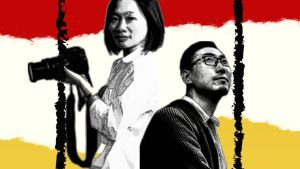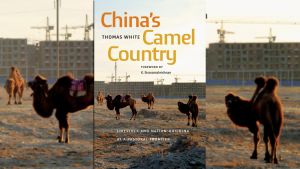
Embodied Borders: The Sino-British Maritime Frontier, 1950–1957
The area that is today known as the Pearl River Delta in fact comprises two deltas, which were historically referred to as the Pearl River and the Lingding Sea. The Pearl River is formed by the confluence of three rivers, the West, North, and East. It runs through the city of Guangzhou and discharges at Humen, the Bocca Tigris. The Lingding Sea extends from the mouth of the Pearl River through the corridor between Macau and Hong Kong and ends (more or less) near Outer Lingding Island in the Wanshan Archipelago (Zong et al. 2009). Westerners may have heard of the Lingding Sea indirectly through ‘Lintin Island’, the common name for Inner Lingding Island (内伶仃岛), which historically marked the gateway to Guangzhou from the South China Sea. In Chinese, the Lingding Sea was made famous in the poem ‘Crossing Lingding Sea’ by the Song loyalist Wen Tianxiang. The poem imaginatively recounts the flight of the boy emperor Zhao Bing (r.1278–79) from Lin’an (present-day Hangzhou) to Yamen. The poem’s pathos is figured by the Song’s defeat at Yamen, where, despite being outnumbered 10 to one, the Yuan navy won a decisive maritime battle, ending the Song dynasty. However, the two landmarks in the poem, Huangkong Shoals and the Lingding Sea, are what suggest how northern armies experienced southern landscapes at the end of the thirteenth century. Huangkong Shoals translates as ‘Terror Shoals’—a reference to a famously difficult passage on the Gan River in Jiangxi Province. Lingding Sea means ‘Lonely Sea’, referring to the vast and underpopulated edges of the empire.
Five hundred years later, the Lonely Sea was no longer an underpopulated frontier. Instead, pirates, privateers, and foreign navies were competing to seize control of the gateway to Guangzhou. Coastal villages and towns occupied both coasts of the Lingding Sea, while islands and bays had been claimed by smaller groups of fishermen and boat-dwellers, who were pejoratively known as Tanka (疍家). Living at the edge of agrarian society, these water-dwellers nevertheless controlled local waters and earned their living working for the highest bidder (Antony 2016). The 1898 Convention for the Extension of Hong Kong Territory made maritime borders explicit; the United Kingdom did not simply lease territory from the Qing, but also (and more importantly) secured maritime access to Guangzhou. The convention did not, however, change the status of coastal, island, and water-dwellers, who were granted traditional water rights. During the war against Japan (1937–45) and the Civil War (1945–49) in southern China, the allied forces of the Kuomintang (KMT) and the United States relied on local water-dwellers to obtain intelligence and supply arms via ports in Hong Kong and Macau (Hou 2019).
The Chinese Communist Party (CCP) rose to power on the strength of its ground forces, only forming the People’s Liberation Army Navy (PLAN) in May 1950, a month before the Korean War broke out. Unsurprisingly, the joint navies of the United States and KMT easily embargoed coastal China. Knowing that ground forces could not hold the coastline, Mao Zedong instructed People’s Liberation Army (PLA) leaders:
The army must leave the coastline, stay in appropriate places to conveniently annihilate the enemy … They should train rather than guard the coastline. It is the responsibility of security teams and local armed forces to monitor spies and kill bandits. Many Communists, after fighting for more than 20 years, have suddenly forgotten their experience, building fortifications everywhere [because] they fear the enemy like tigers. (Hou 2019: 248)
Instead, another strategy—one based on CCP experience in guerilla warfare and local organising—was necessary if the CCP was to wrest control of Chinese coastal waters from the United States and the KMT. Over the next few years, the CCP would rely on its experience of land reform (in 1950–52) and the campaign to suppress counterrevolutionaries (December 1950 – October 1951) to integrate water-dwellers into its maritime defence strategy, just as peasants had been integrated into its ground war strategy. This entailed resettling water-dwellers, while blockading Hong Kong via the islands of the Wanshan Archipelago. In turn, the consolidation of the coastal frontier occurred via the transplanted fishermen and islanders. Their bodies, settlements, and labour made the Sino-British border visible, asserting Chinese claims to the coastline.
The story of Fishing One Village (渔一村) highlights how these larger processes not only transformed the cultural geography of the Lingding Sea, but also laid the foundation for the establishment of the China Merchants Shekou Industrial Zone in 1979. On the one hand, through the stories of Fishing One, we see how the so-called democratic fishing reform (alternatively known as 渔民民主改革 or 渔业民主改革) reshaped the cultural geography of the Lingding Sea. Previously, mobile ‘fishing despots’ (渔霸) had patrolled the water, but, after the fishing reform, boat-dwellers could no longer freely sail the seas. Instead, they worked out of fixed ‘fishermen villages’ (渔村), which the state could mobilise as necessary, effectively landlocking water-dwellers without giving them full status onshore. On the other hand, these stories also highlight how the region’s fluid borders were first consolidated through revolutionary methods. Once the borders were secured, later development of the coast became feasible precisely because the coastline was de facto located within Chinese—and not British—territory. When Yuan Geng decided to establish the China Merchants Shekou Industrial Zone, for example, the port, industrial park, and its factories not only incorporated the coastline from the high-tide mark, but also extended the coastline through land reclamation into what (at the time) were acknowledged to be British waters.
Reorganising the Lingding Sea
In 1949, the Central Committee of the CCP entrusted the task of securing China’s southern coast to Ye Jianying, head of the South China Branch Bureau. The situation was daunting. More than one million people, including boat-dwellers, inhabited the coastal waters of Guangdong Province. Historically, these people had formed groups based on language and labour, enjoying relative autonomy from state oversight. Fishing reform in coastal waters (1951–54) and policy consolidation during the following three years (1955–57) allowed the CCP to occupy the southern coastline, pushing back against the historical frontier. The organisation of fishermen and territory was contemporaneous with the Socialist Transformation Movement (December 1951 to the end of 1956). Drawing on the ideas of the Agricultural Cooperative Movement, the Bao’an County Government encouraged fishermen to come ashore, aiming to enclose them within prescribed boundaries that simultaneously secured the coastline and improved the lives of the poorest fishermen. Once the fishermen were onshore, the government set up mutual aid groups, which were the embryonic form of fishermen’s villages (渔民村).
In 1950, the leading organisation in Bao’an County was the Shashenbao branch of the Guangdong Military Administrative Commission (广东军事管理委员会沙深宝分会), with Qi Feng as director. There was debate over whether islands should be administered by the Bao’an Government or by the Military Commission. Ma Lun, the Bao’an County Secretary, for example, maintained that the Bao’an County Government should only administer the territory within its land borders, while the management of waters and islands fell under the purview of the Shashenbao Committee. As a result, local fishermen’s groups were not placed within the Bao’an County Government (as Qi Feng had hoped), but within the Island Administration Bureau. The two fishermen’s groups in Bao’an County became the East Island and West Island offices, corresponding to the county’s eastern and western coasts. That year, there were about 600 people living on Inner Neilingding Island, including more than 120 fishermen. Due to military necessity, the PLA was stationed on the island and the islanders were relocated to Shekou and Xixiang.
In January 1951, Guangdong Province set up the Pearl River District Commission Office, Island Administration Bureau, and Post Reform Management Office (珠江区专员公署海岛管理局后改管理处). Responsibility for organising fishermen’s work was transferred from the Shashenbao Border Committee to the Island Administration Bureau. Jurisdiction over Inner Lingding Island, the islands of the Wanshan Archipelago and coastal islands from Zhongshan, Dongguan, and Bao’an counties was transferred to the new bureau. The Island Administration Bureau’s office was set up in Tangjiawan, Zhuhai (珠海唐家湾), a coastal subdistrict (乡) in Zhongshan County. In practice, this meant that, although Inner Lingding Island fishermen had been resettled in Bao’an and their cadres were considered part of the Bao’an Government, they were nevertheless to make annual trips to Zhuhai to report on their work.
The reorganisation of previously scattered islands under one administrative entity was an important step to organise fishermen. Zhou Enlai, first premier of the People’s Republic of China, and Liao Chengzhi, the Hong Kong–based official in charge of the United Front and overseas Chinese, asked the relevant departments to help fishermen establish their homes on land. Once ashore, fishermen could be assigned a political identity, land resources, and finally be organised into villages, which was the most basic unit of rural administration. To this end, the Fishermen’s Association Committee (渔民协会委员会) was established in 1951. Status in the Fishermen’s Association was based on physical residence. Fishing families with a fixed residence on land were defined as ‘fishermen’ (渔民) and would ultimately receive hukou (户口; ‘household registration’) based on that settlement. Fishing families who had no fixed residence on land and travelled between harbours in Bao’an, Hong Kong, and Macau were defined as ‘itinerant fishermen’ (流动渔民), ultimately receiving identity cards in Hong Kong. The organisation of fishermen was also a mobilisation of resources. The local Party committee established a democratic reform committee, which worked with local cadres to organise a work team to develop and train activists among fishermen, teaching them to distinguish between the ‘enemy and ourselves’ (敌我问题). In the first stage of the fishermen’s democratic reform (1951–52), local political groups dealt with the smuggling of intelligence and weapons to the United States, Taiwan, and Hong Kong.
In July 1952, during the second phase of the fishermen’s democratic reform, the Island Administration Committee transferred the governance of islands to Zhongshan County—an administrative shift from party to government. This shift emphasised location (rather than a specific mission) as the principle for governance. On this basis, on 19 November 1952, the CCP Central Committee issued a set of ‘Instructions on Fishermen’s Work’, stating: ‘Coastal fishermen should also divide fishermen’s counties and districts according to their fishing areas, with a port as the centre’ (Chen 2019: 100). According to the relevant materials, the boundaries of the fishermen’s county referred to the southern Lingding Sea and included most of the islands therein. The new county would be called Zhuhai, with its county seat at Tangjiawan. In July 1953, Bao’an County designated West Sea, East Sea, Nantou, and Yantian as pilot areas to carry out the local fishermen’s democratic reform. Significantly, fishing areas crossed the maritime border. The West Sea, for example, included waters near Shekou and islands in the Wanshan Archipelago, as well as near Tsing Shan, Tuen Mun, on the northeastern coast of the Hong Kong New Territories. Similarly, East Sea waters included those near Yantian and Yazhou Bay as well as near Sai Kung on the northeastern coast of the New Territories. At this time, Bao’an County became responsible for the fishermen who had been relocated from Inner Lingding and Dachan islands to Shekou and Xixiang. This was the first appearance of ‘Shekou’ among Chinese administrative placenames.
From 1953 through to 1954, local Party representatives organised fishermen through campaigns in democratic struggle, democratic unity, and democratic construction. Fishermen were also encouraged to join the fishing trade union, the Fishing Association, the Communist Youth League, militia, and other organisations. Organisers united fishermen according to the logic under which peasants had been united, encouraging better-off fishermen to employ poor fishermen. Although fishermen could not be classified as ‘poor’ or ‘middle-income’ based on how many tools they owned (as was the criteria for classifying peasants), some fishermen owned boats and others did not. Fishermen with boats could work alone or were encouraged to employ one or two people. During the 1954 fishery cooperative movement (渔业合作化运动), whether or not one maintained ‘fisherman’ or ‘floating fisherman’ status was based on joining the cooperative and the sharing of boats. Most residents in the Shekou area, for example, joined friends and family in the fishing cooperative, while those who chose not to join became itinerant fishermen, taking up residence in bays along the coasts of Hong Kong and Macau. In contrast to the West Sea area, there were more floating fishermen in Mirs Bay in the East Sea area.
The differences between fishermen and itinerant fishermen were not immediately consolidated but were settled over the course of the decade. Shekou, for example, is home to two fishing villages, the aforementioned Fishing One and Fishing Two (渔二村). The root of Fishing One was the Inner Lingding Island mutual aid group. Fishermen Wu Jindi, Zhou Dezai, and several others who had lived on Inner Lingding Island and owned houseboats (罟仔艇 or Kwu Tzu boats) became core members of the Inner Lingding Island mutual aid group after their relocation to Shekou. Their status allowed them to receive interest-free or low-interest loans from the Bao’an County Government to update their fishing equipment. Funds were also used to set up marketing cooperatives to help these fishermen sell their products. By 1954, cooperation and a guaranteed market meant that organised fishermen could expand their enterprises. In contrast, activist Zhang Meitou set up Bao’an County’s first fishery production cooperative in Shekou with resettled boat-dwellers. With government help, the cooperative purchased new fishing equipment and began deep-sea fishing. However, unlike Fishing One, which comprised members from the same linguistic group and a shared home island, fishing cooperative members came from Haifeng and Panyu. Due to the differences in customs and languages, the cooperative dissolved in less than two years. Some of the Teochew-speaking fishermen opted to return to Haifeng and become farmers, while some of the Cantonese-speaking fishermen moved to Hong Kong, becoming itinerant fishermen. In fact, it was not until 1957 that the cooperative was successfully reorganised as Fishing Two Village (Shekou Museum of Reform and Opening Up 2019).
Onshore but Not of the Land
Although islanders, fishermen, and boat-dwellers were assigned ‘villager’ status, they did not enjoy the same treatment and historical rights as farmers. Specifically, while farmers continued to have rights to cultivated land and housing plots via collectives that were based on historical settlements, fishermen lost their historical rights once they were relocated. In Shekou, for example, islanders were given berths only at local typhoon shelter wharfs and were not permitted to build housing on land. The question of where Inner Lingding Islanders were entitled to land arose because their jurisdiction had not been settled. In 1952, when Zhuhai was split from Zhongshan and redistricted as the fishermen’s county, it was given jurisdiction over Inner Lingding Island. However, islanders were already residents of the Shekou and Xixiang areas of Bao’an County since their resettlement in 1950. Neither Zhuhai nor Bao’an was willing to take responsibility for giving the islanders onshore plots. In Shekou, the islanders’ housing situation was only resolved in 1970, when Shekou Commune allocated a section of coastal land belonging to Wanxia Village (湾厦村) to the islanders. In Xixiang, those who came on land did not remain ‘fishermen’. Instead, housing plots were created through reclamation of coastal fishponds and polders, which were known as jiwei (基围). Islanders, fishermen, and boat-dwellers on the western Bao’an coast (from Xixiang to Shajing) who received these plots became ‘jiwei people’, living in shacks at the edges of landed villages. The main livelihood of jiwei villagers was raising fish, shrimp, and crab in coastal polders. As land reform deepened, jiwei people were divided into village units; however, because they did not have a traditional land residence, these new villages were given revolutionary names, including Turn Over (翻身村), Labour (劳动村), Freedom (自由村), Settled Happily (安乐村), Peace (和平村), Happy Together (共乐村), and Democracy (民主村) villages.
In 1979, China Merchants established the Shekou Industrial Zone, which was set up for logistics and basic manufacturing. The new entity inherited not only the reorganised coastline, but also the rights to plan and develop it. Fishing One Village took advantage of Reform and Opening Up to pursue private enterprise, including selling seafood in Hong Kong and Shekou. That same year, Inner Lingding Island was reassigned to Shenzhen City. In 1989, based on its historical relationship with Inner Lingding Island, Fishing One raised 13 million yuan and borrowed 9 million yuan to invest in the construction of a resort on the island (Shekou Museum of Reform and Opening Up 2019). However, due to the unclear jurisdiction, there were frequent conflicts among Zhuhai, Shenzhen, and Fishing One over what residual rights villagers had. During a provincial survey meeting in 1993, Fishing One’s head, Zhou Dezai, angrily exclaimed: ‘We were born and raised in Bao’an for generations, and all of a sudden we have become Zhuhai people. What is the basis of this claim? I’ll die with eternal regrets’ (Shekou Museum of Reform and Opening Up 2019). His words proved prophetic and he died soon after. Unfortunately, it was not until his death that the Guangdong Provincial Government made greater efforts to clarify administrative oversight over Inner Lingding Island. It did not, however, return the islanders’ native holdings and the resort project was ultimately abandoned.





